Is Showit Good for SEO? Pros, Cons & Honest Thoughts
March 12, 2025
One of the questions that my clients often ask me on discovery calls is whether Showit is good for SEO. As a Showit brand & website designer, I work with creatives like therapists, photographers, and artists who understand that strong SEO = more organic visibility and leads from Google.
So, is Showit good for SEO? The simple answer is YES, Showit can be an amazing platform for SEO. That said, just like any other website builder, its effectiveness boils down to how you implement its SEO capabilities.
Ultimately, it’s not the platform itself that determines SEO success – what you do with it is.
In this guide, I’ll break down Showit’s strengths and weaknesses in SEO. I’ll also explain a few important SEO settings that you should know about!
These are my honest thoughts as a Showit Design Partner who now exclusively uses Showit but has extensive experience with other website builders, such as Squarespace, WordPress, and other popular platforms.
What Is Search Engine Optimization (SEO)?
SEO stands for Search Engine Optimization. It’s the practice of optimizing your website to rank higher in search results like Google, bringing you free, organic traffic.
When I explain SEO to my creative entrepreneur clients, I describe it as creating a direct path between your target audience’s search queries and your website.
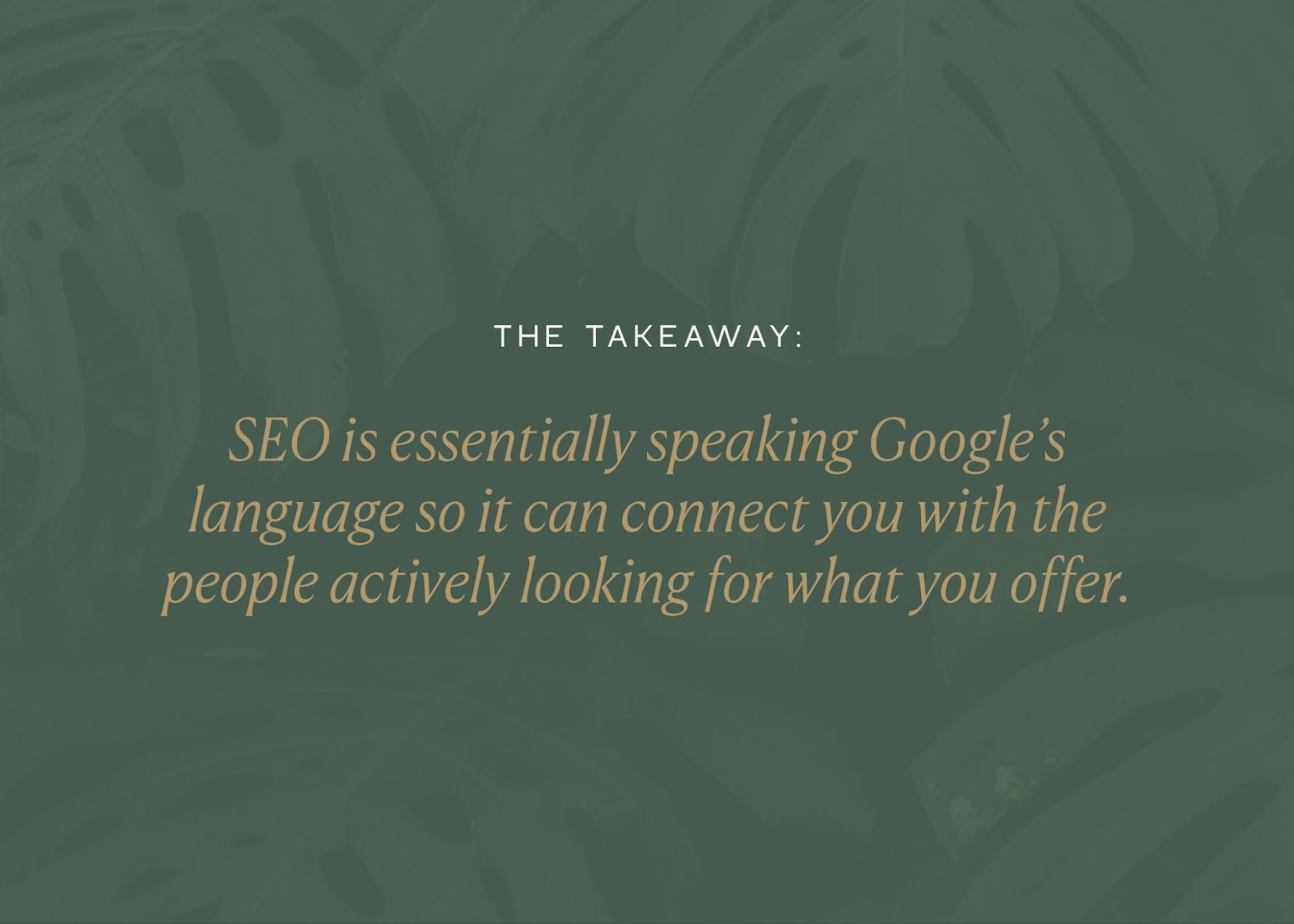
SEO is especially valuable for creative businesses such as:
- Therapists
- Photographers
- Wedding professionals
- Artists
- Coaches
- Copywriters
- Interior designers
- Landscape designers
- Local businesses
- Service providers
If you have a local business, such as a restaurant or a landscaping business, SEO can also help you position yourself in front of the clients in your area. 29% of marketers report that organic search has the highest ROI compared to other marketing channels.
The true beauty of SEO is its longevity. The content you create will continue to bring in traffic to your website from Google and other search engines for years.
Unlike social media marketing that requires constant content creation, SEO creates assets that continue working for you over time!
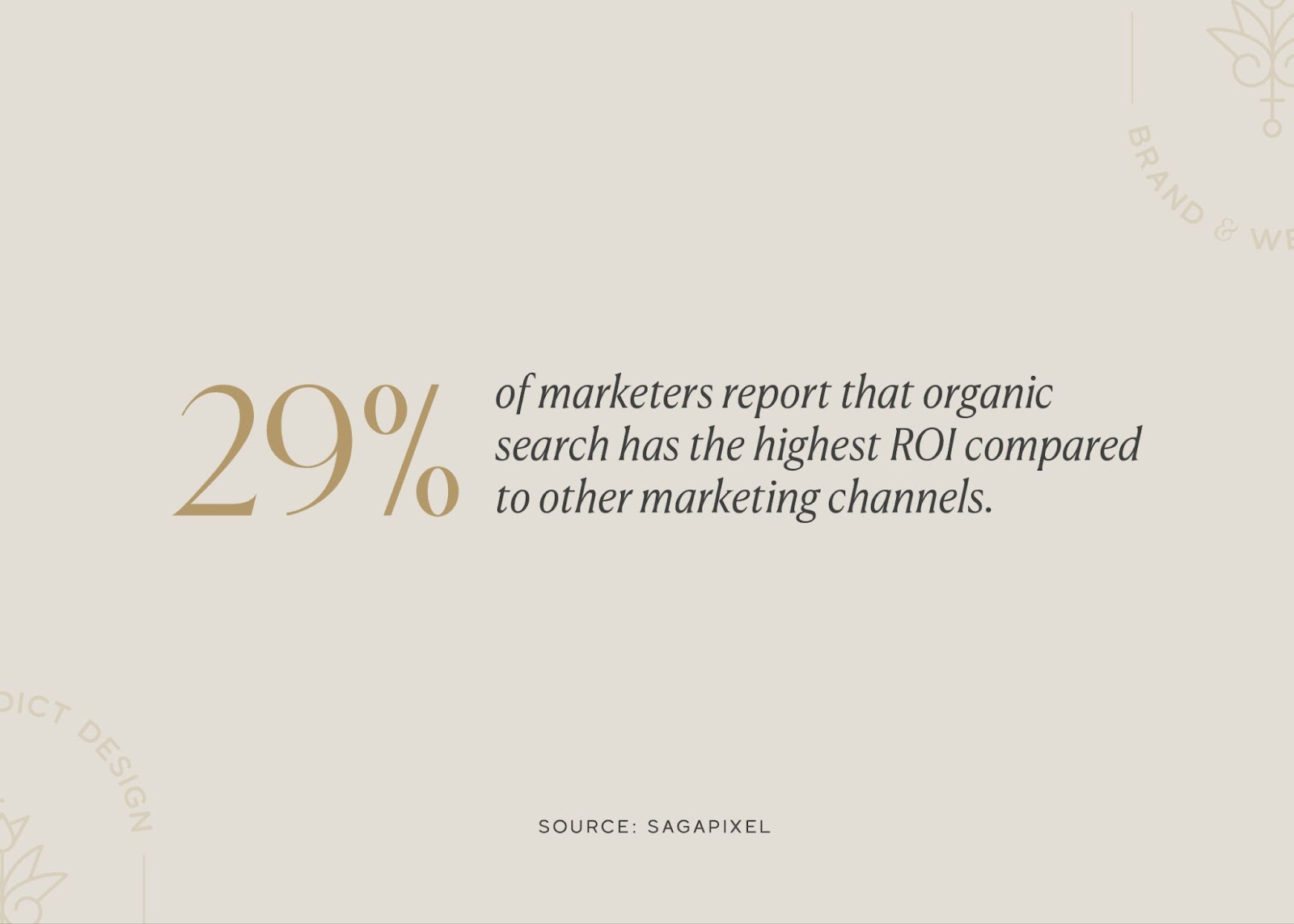
Does Showit Have Good SEO?
Yes, Showit absolutely has good SEO capabilities! The website platform gives you all the essential SEO features you need to rank well in search engines and bring in website traffic. However, just having these features isn’t enough – you need to actually implement them consistently across your site.
I also find that Showit’s intuitive interface makes it easier for my creative clients to maintain their sites after launch. This is important because regularly updating your website with fresh content is a key factor in SEO success. If your platform is clunky, you’ll naturally want to be on it less. It’s unlikely you’ll have this problem with Showit.
The Pros of Showit for SEO

Showit has a few important features that can boost your appearance in Google search results when you use them correctly:
- On-Page SEO Settings: Showit makes it easier than other website-building platforms – in my opinion! – to optimize essential SEO elements like your page titles, meta descriptions, and alt text for images so you have control over how search engines interpret your pages.
- SEO Blogging: Showit users can take advantage of the platform’s integration with WordPress for blogging. WordPress is one of the best platforms for blogging that search engines love, and with Showit, you get both the beautiful design and strong blogging functionality.
- Automatic SSL Certificate: Now, this is a little technical, but every Showit subscription includes an SSL certificate, which encrypts your site with HTTPS. This is a security feature, but it’s also an important ranking factor for Google.
- Nonfollow Links: This is another technical quirk, but Showit makes it easy to mark links as “nofollow,” which helps you manage how your site’s authority flows to external websites – an important factor for search engine results. Other website platforms also typically allow you to do this, but it’s just not as intuitive.
- Heading Tags: With Showit, you can assign heading tags (like an H1 or an H2) to any text without changing how it looks. For example, if you wanted your H1 tag to be assigned to a sentence in a small font, you could do that without a problem. Many other website builders automatically enlarge chunks of text that are tagged H1, H2, or H3, which can mess with how you want things to look.
- Mobile Responsiveness: One of the coolest things about Showit is that you can create a separate mobile version of your website! With over 62% of global website traffic coming from mobile devices, it’s super important for your website to be easy to navigate when you’re on your phone. Having a responsive mobile site is great for user experience, but it can also give you a nice SEO boost.
- Fast Performance: Showit websites generally load quickly, which is essential for both user experience and search engine rankings.
Overall, Showit has both basic and advanced settings for SEO purposes, and it’s my absolute favorite platform for creative website design!
It doesn’t necessarily have a ton of proprietary, unique SEO features, but it DOES make it much easier for creatives who might not be super tech-savvy to use SEO settings correctly than other website-building platforms.
What Are the Downsides of Showit for SEO?
Like any platform, Showit has a few quirks when it comes to SEO. In my opinion, it’s nothing major, but there are some technical things to watch out for.
Working with a Showit designer who understands SEO can help you avoid these issues completely since they’re mostly technical backend things that you run into when you’re creating a new website.
- Since Showit lets you design desktop and mobile versions separately, problems can pop up if elements aren’t handled correctly. For example, text might be hidden on mobile but visible on desktop, which can confuse Google when you do it excessively.
- It’s possible to mix up image titles and ALT text if you’re unfamiliar with how they work on Showit. Showit has a separate text box for the image title and the ALT text properties, and sometimes people confuse them. The image title should concisely describe what the visual is (“artist-looking-at-a-painting”), and the ALT text is a longer description that should ideally incorporate your target keyword or its synonyms while sounding natural.
- Sometimes URLs can break during updates if you’re not paying enough close attention to them.
These aren’t really SEO problems, they’re potential technical issues that can come up if you’re not sure how to use certain features of Showit correctly. Every website builder has these kinds of challenges, and in my experience, Showit has fewer of them than other platforms.
Overall, Showit tries to make things as SEO-friendly as possible. But when you’re building your site yourself without much website experience, you probably won’t get the full SEO benefits because there are so many small details to watch out for!
Working with a website designer who’s experienced with Showit SEO questions helps you take the headache out of it and make sure that all of the technical elements – such as nofollow links, title tags, alternative text, and mobile design – are handled properly.
It’s important to be aware that website design – whether on Showit or another platform – isn’t just about pretty visuals (although they’re important, of course!) but also about making sure that your backend is solid for SEO.
If you’re a creative looking for SEO-friendly website design on Showit, learn more about my services!
Is Showit Good for SEO? My Honest Thoughts
Yes, Showit is good for SEO. Even though not every feature is perfect, I believe it’s the best website builder for creative businesses when it comes to SEO – if you use it properly.
Your SEO success ultimately depends on many factors beyond just your website platform:
- How competitive your industry is
- The quality of content you create
- How consistent you are with blogging
- Whether you’re targeting the right keywords
- If you’re building quality backlinks to your site
- How well you understand your target audience’s search habits
So, TL;DR – Showit gives you all the tools you need to succeed with SEO, but whether or not you do entirely depends on how you use the platform.
If you’re serious about building Showit SEO, I recommend building a website with good SEO foundations and then starting a blog. Blogging regularly about topics your ideal clients are searching for is the fastest way to improve your search rankings!

Showit Website SEO Settings to Know
Page Titles
Your page title is the main heading that appears at the top of your page. In HTML terms, this should be tagged as an H1. This title tells both visitors and search engines what your page is about, and it should naturally incorporate your target keyword.
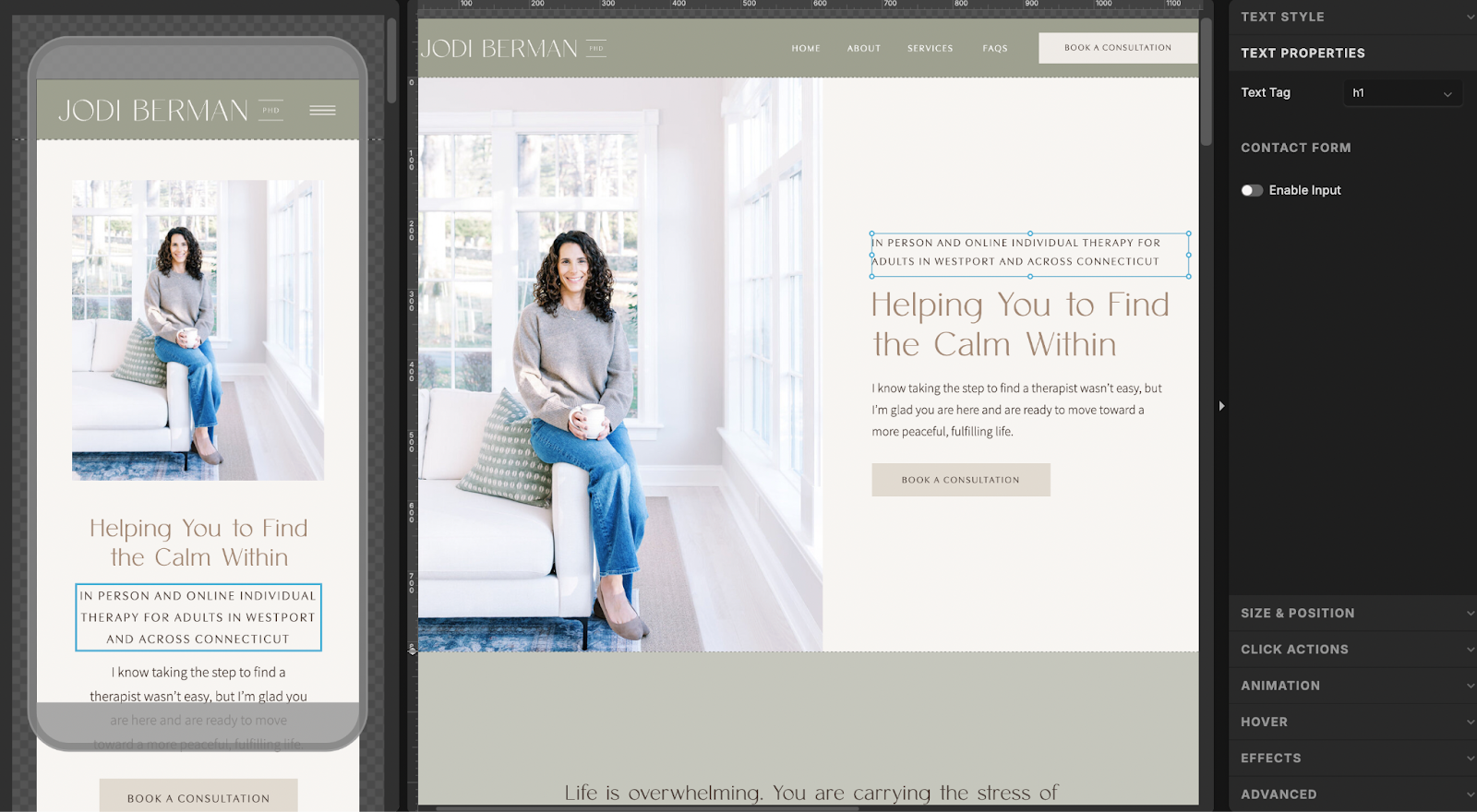
In Showit, you can simply add a text box and select “Title” from the text options, which automatically assigns it an H1 tag. If you already have text you want to use as your page title, check that it has an H1 tag by going to the “Text Properties” panel and setting the “Text Tag” to H1.
Make sure to only use one H1 tag per page! Multiple H1 tags can confuse search engines about which heading is your main title.
Title Tags
The title tag is different from your page title. It’s what appears as the clickable blue link in search engine results. Google can use your H1 as the title tag, but it’s always better to set it specifically.

To set your title tag in Showit, select your page from the left sidebar. Then click the page name at the top to make sure no canvas is selected. On the right panel, open “SEO Settings” and edit the “Page Title” field. This is where you enter the text you want to appear in the search results.
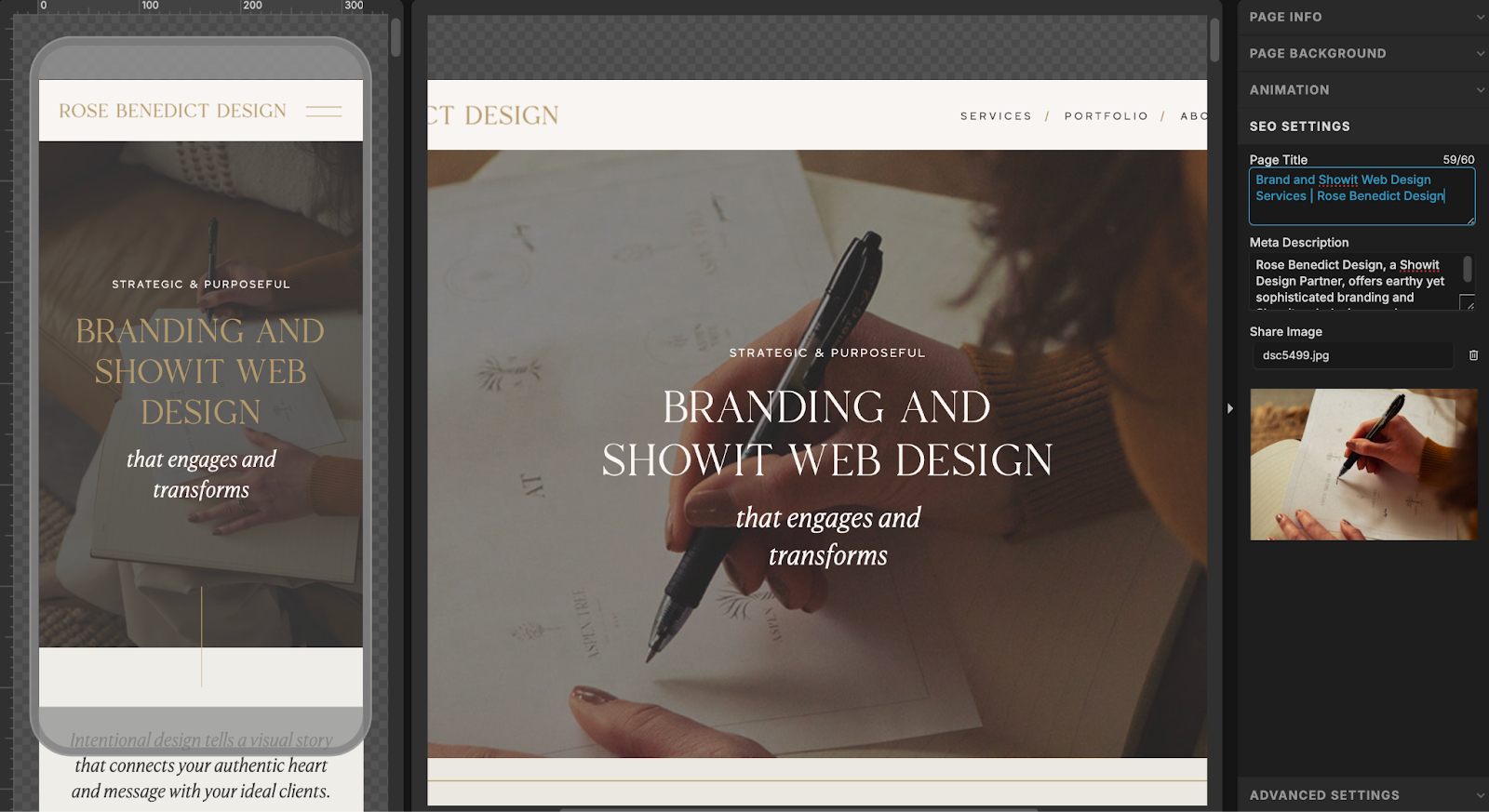
Don’t confuse your title tag with your page name, which affects your URL! Changing the page name after publishing can break links to your page unless you set up redirects.
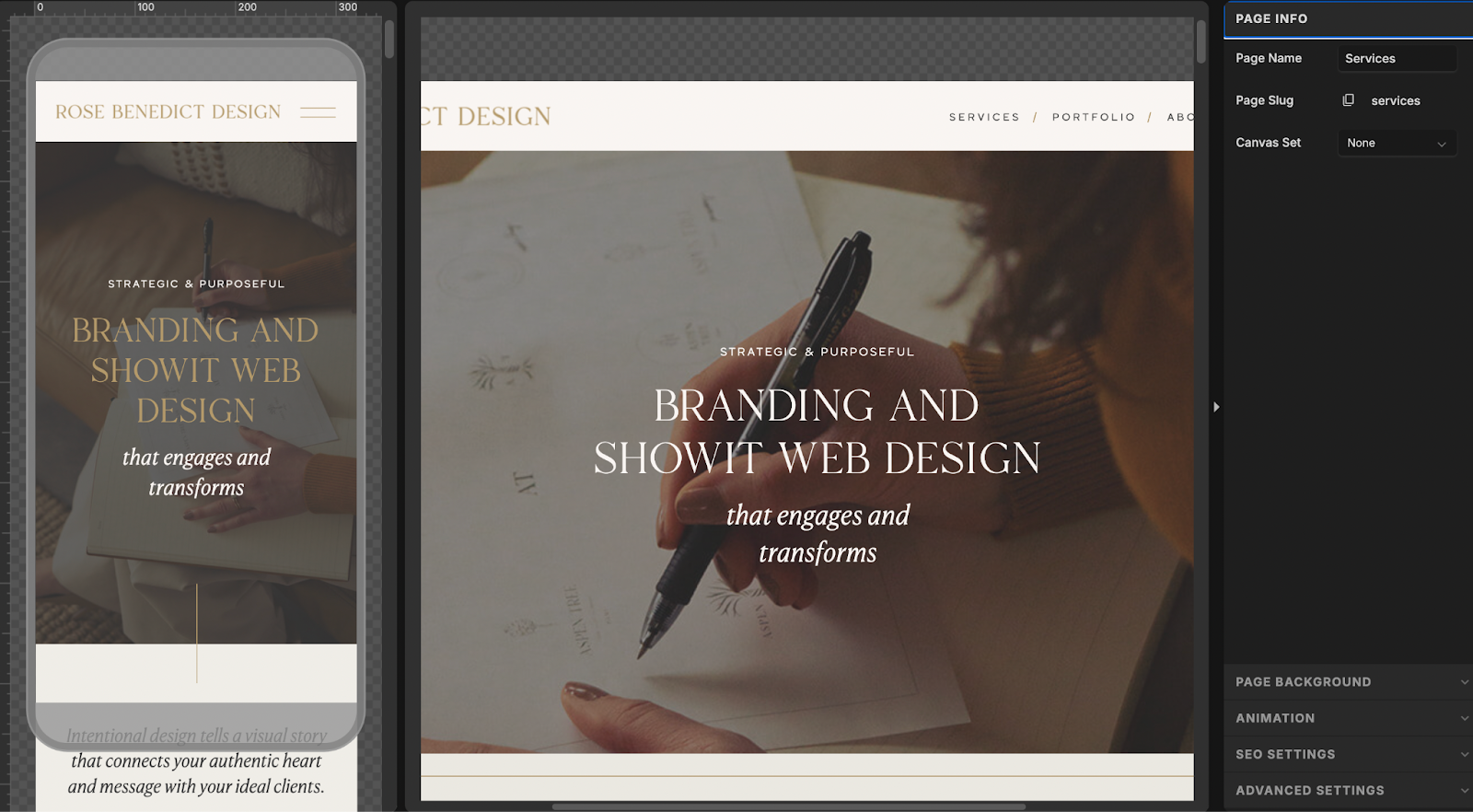
Also, make sure that the “Ask Google to ignore this page” option is unchecked unless you specifically want to hide that page from search results. Checking this option will “hide” the website page from Google.
Meta Descriptions
Your meta description is the short summary that appears under your title in search results.

Google doesn’t use meta descriptions as a direct ranking factor. In other words, simply incorporating your target keyword in your meta description and hoping for the best likely won’t make a difference for your SEO.
BUT meta descriptions are important for your click-through rate, which IS an important SEO factor! So, try to write catchy and compelling meta descriptions for all of your website pages, and if they naturally incorporate your target keyword, that’s even better.
In Showit, set your meta description in the same “SEO Settings” panel where you edited your title tag. Keep it between 120 and 155 characters, and write it as a clear call to action that entices people to click through to your page.
ALT Text
ALT text (alternative text) describes what’s in your images. It makes your website more accessible and helps with SEO.
When you add an image to your Showit site, select it and look for the “Image” panel on the right side. You’ll see an “Alt Text” field where you can enter your description.
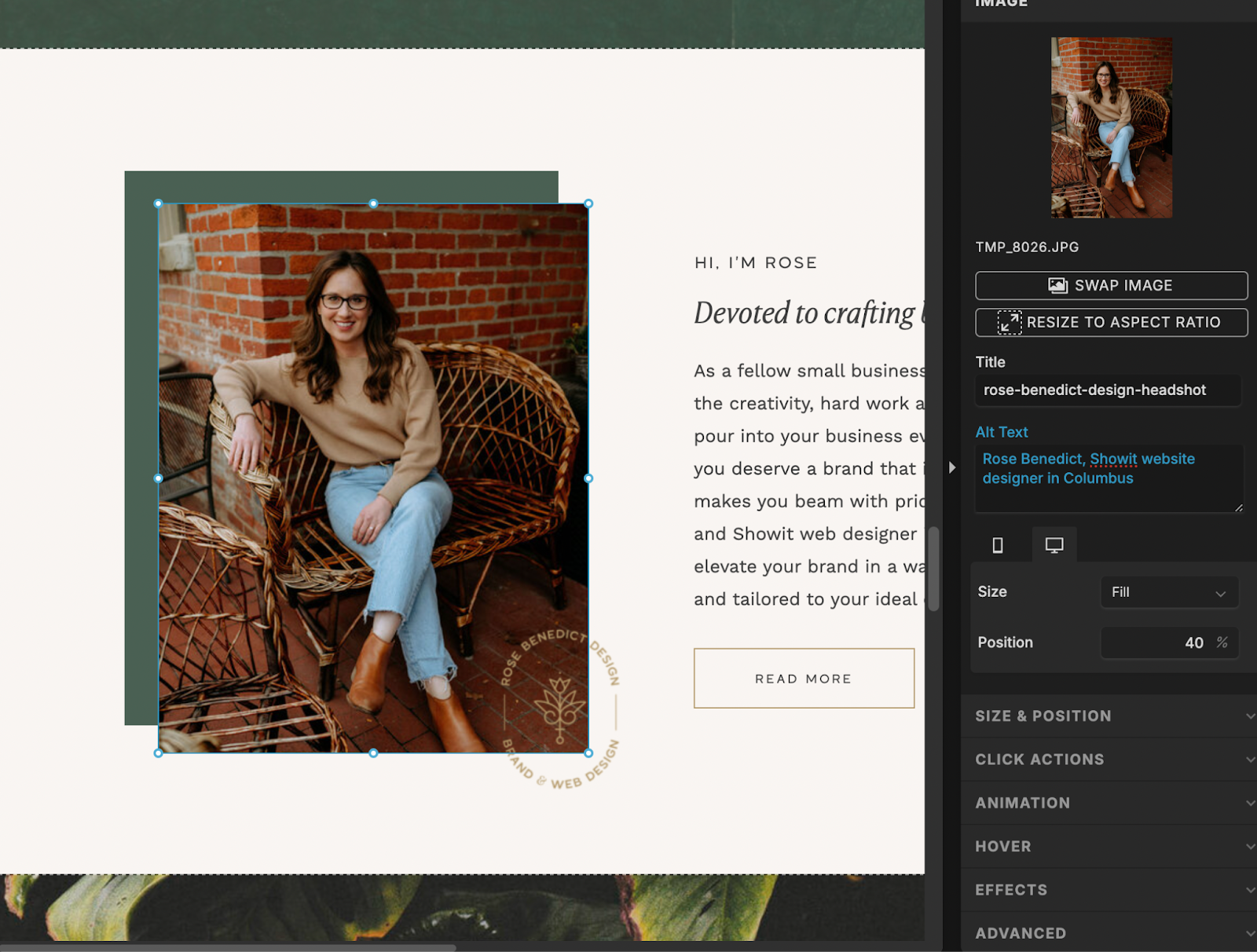
Write a clear, specific description of what’s in the image using natural language. If the image relates to a keyword you’re targeting, include it naturally, but don’t stuff multiple keywords in.
For example, instead of writing “photographer portfolio headshot professional,” write something like “Headshot of Sarah Smith, wedding photographer in Portland.” This helps both search engines understand your image content and makes your site accessible to visitors using screen readers.
I’ve seen many Showit users confuse the image title with ALT text. They’re different things! Your image title (like “sarah-smith-headshot.jpg”) should be descriptive before uploading, but you still need to add proper ALT text separately.
Make sure to add ALT text to every image on your site! Even if an image is purely decorative, adding a simple ALT text like “decorative floral element” is better than leaving it blank.
SEO Blogging
When you sign up for a Showit plan with blogging, you get a WordPress blog that’s fully integrated with your Showit site.
This means you create and publish blog posts through WordPress while maintaining your Showit design across your entire site!
The WordPress integration comes with Yoast SEO, the industry-standard plugin for optimizing blog content. Yoast gives you real-time feedback on how well your post is optimized for search engines.
It checks things like keyword usage, readability, meta descriptions, and internal linking. It even shows you a preview of how your post will appear in search results.
Blogging is one of the best ways to boost your SEO! You can target keywords that your target audience is searching for so that your potential clients find helpful answers to their questions and discover your brand.

Over time, this will build your site’s authority on topics relevant to your business and bring in more organic traffic. More people finding your business on Google = more qualified leads and clients! 💃
What I Do as a Designer for Your Showit Site
When you work with me, comprehensive on-page SEO optimization is already included in your website design package! This is what I typically do:
- Conduct basic keyword research using tools like Ubersuggest and Ahrefs
- Create strategic SEO titles for each page that include your primary keywords
- Write compelling meta descriptions that encourage clicks from search results
- Incorporate relevant keywords naturally throughout your page content
- Add descriptive ALT text and file names to images
- Properly structure your content with H1, H2, and H3 tags in the correct hierarchy
- Organize your site content in a way that makes sense to both visitors and search engines
- Submit your new sitemap to Google Search Console so your pages get indexed quickly
- Set up redirects from your old website URLs to prevent broken links
- Design a custom 404 error page so your visitors stay on your website even if they hit a dead end
I don’t offer specialized services like SEO copywriting or blogging, but I can provide recommendations for service providers that I trust! I also don’t delve into super complex SEO issues that extend far beyond on-page SEO, but I have recommendations for providers who do.
Showit SEO Is a Long-Term Strategy
SEO is absolutely a long game. You don’t typically make huge jumps overnight, but the results are more sustainable and long-lasting than for many other marketing channels! On average, it takes 3 to 6+ months to start seeing SEO results.
The SEO process starts with setting up your website correctly, which is what I do as your designer. Then, I recommend my clients to start a blog and regularly publish high-quality content on topics that are relevant to their audience.
Not all blog posts are created equally! It’s important to use solid SEO practices when blogging, or your posts likely won’t rank well.
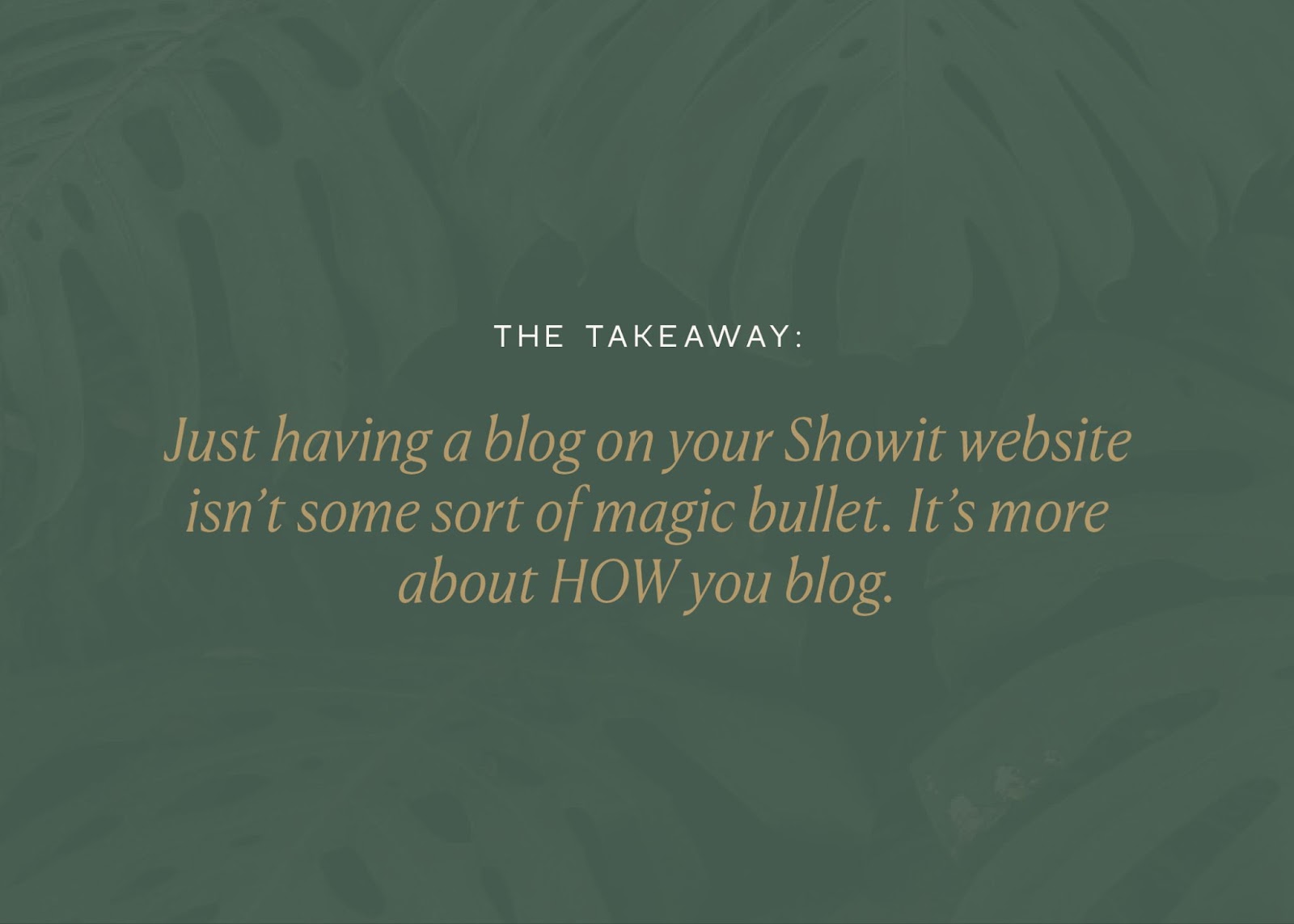
So, educate yourself on the best blogging practices (there are tons of free YouTube videos and paid courses!), or, if you don’t have time or desire to learn search engine optimization, you can work with an SEO blogger!
FAQs
Do I Really Need SEO for My Website?
If you value sustainable marketing that works for you over the long term, then YES, you need SEO for your website! Without SEO, your website won’t appear in search results, which means that you’ll have to rely on social media, word of mouth, or paid ads to bring you new leads. I’m not saying that those marketing channels are inherently bad – and they can definitely work together with SEO – but they require either a lot of your time or investment (or both). Eventually, SEO can help you get a steady stream of organic leads from Google without having to pay for it or show up constantly. Plus, your website and its SEO are assets you actually own. You don’t own your social media profiles.
SEO can be an especially valuable marketing strategy for creatives and service providers who have a local presence, such as photographers or therapists.
How Do I Add SEO to My Showit Website?
Google evaluates your website holistically, not just its individual elements. First, you should make sure that your website launches with proper technical SEO structure, such as title tags, meta descriptions, heading hierarchy, and image optimization. Then, grow and maintain your SEO with regular updates, especially blogging about topics that your target audience is searching for. I recommend creating a content schedule and focusing on quality over quantity. Publishing even one in-depth, genuinely helpful blog post every month can make a huge difference over time!
Which Platform Is Best for SEO?
No one platform is best for SEO because it ultimately comes down to how you use it and implement SEO best practices within it. Showit has strong SEO capabilities, but this doesn’t mean that your website won’t rank if you build it on another platform, such as Squarespace or WordPress. I exclusively use Showit for my clients because it’s good for SEO but also because it has a user-friendly interface that makes it easier for you to update it as your business grows (which is an important SEO factor, too!). The best platform is ultimately the one you’ll actually use consistently.
Is Showit Better Than WordPress?
Showit and WordPress both have strong SEO features, but I prefer Showit because it’s much easier to use and doesn’t have a steep learning curve. WordPress’s backend can be very clunky, which often discourages creative entrepreneurs from maintaining their sites – which ultimately hurts your SEO. Showit also integrates with WordPress for blogging, so you essentially get the best features of both platforms with one subscription.
Which Is Better, Wix or Showit?
There’s no black and white answer to this question, but I absolutely prefer Showit over Wix. Wix has built-in SEO features the way Showit does, but in my opinion, they’re harder to use, and the website design comes out much weaker – both in terms of the aesthetics and SEO. Showit gives you complete creative freedom and strong SEO. That said, you can, of course, make a Wix website work…it’s just a much weaker platform than Showit in my experience as a designer!
Is Showit or Squarespace Better for SEO?
Showit and Squarespace both have the essential SEO tools that you need to rank on Google. From a pure SEO perspective, Showit’s WordPress blog integration gives it a slight edge over Squarespace. I also believe that Showit website designs are more aesthetically pleasing and creative because you’re not stuck with Squarespace’s grid system. You can build strong websites on both platforms, but I personally would always choose Showit!
Build an Earthy & SEO-Friendly Showit Website
So, is Showit good for SEO? My verdict is YES. After years of building websites across multiple platforms, I firmly believe that Showit has the perfect balance of creativity and technical SEO features for creative entrepreneurs.
That said, it’s not without its technical quirks, so it’s important to spend some time getting to know the platform and becoming comfortable with using it. SEO isn’t a quick win, but it’s a sustainable marketing strategy that can bring fantastic results over time!
If you’re ready to build an SEO-friendly Showit website, learn more about my design packages!

About the Author:
Rose Benedict
Owner and Designer, Rose Benedict Design
Rose Benedict is a brand and website designer for therapists, creatives, artists, and service providers. Rose is also a Showit Design Partner and the owner/designer at Rose Benedict Design. She has been a designer for the past 10 years and has worked at a Fortune 15 company and top university in Columbus, Ohio. She brings both her brand/website design and technical experience to small business owners so that they can thrive and deeply connect with their ideal clients. Outside of work, Rose loves reading, pilates, gardening, and traveling (10 countries and counting!).
Rose Benedict Design is a brand and Showit web designer based in Columbus, Ohio, devoted to crafting beautiful, strategic brands for creatives and service providers.
©2022-2024 ROSE BENEDICT DESIGN
Rose Benedict Design is a proud Showit Design Partner.